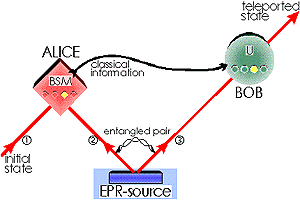



If ALICE wants BOB to have an exact replica of her particle, they first share an entangled pair of particles. Entanglement means that neither particle has properties of its own, they only have common properties. E.g. for the state
 : "particle 2 is orthogonal to
particle 3".
: "particle 2 is orthogonal to
particle 3".
ALICE now combines particles 1 and 2 and, by a
Bell-state measurement (BSM),
projects them onto an entangled state, e.g. onto  .
Thus, she gains the information about the specific quantum states of
particle 1 or 2 before the measurement. However, she knows, that,
whatever the states have been before, they are orthogonal to
each other.
.
Thus, she gains the information about the specific quantum states of
particle 1 or 2 before the measurement. However, she knows, that,
whatever the states have been before, they are orthogonal to
each other.
Now, if the state of particle 1 is orthogonal to the state of particle 2, and if the state of particle 3 is orthogonal to the one of 2, then the state of particle 3 must be equal to the initial state of particle 1.
However, ALICE could have obtained any of the other three Bell-states with the same probability. She tells BOB which result she obtained via a classical channel. Then BOB turns particle 3 with one of four unitary transformations (U) into an identical replica of particle 1.
[ Home
| Idea
| Experiment
| Source
| Bell States
| Results
| Links
]
Text: HW
Layout: MW.